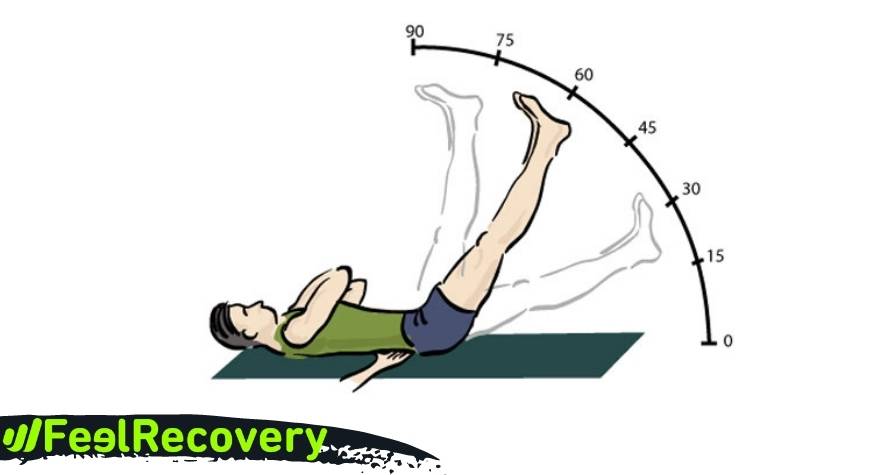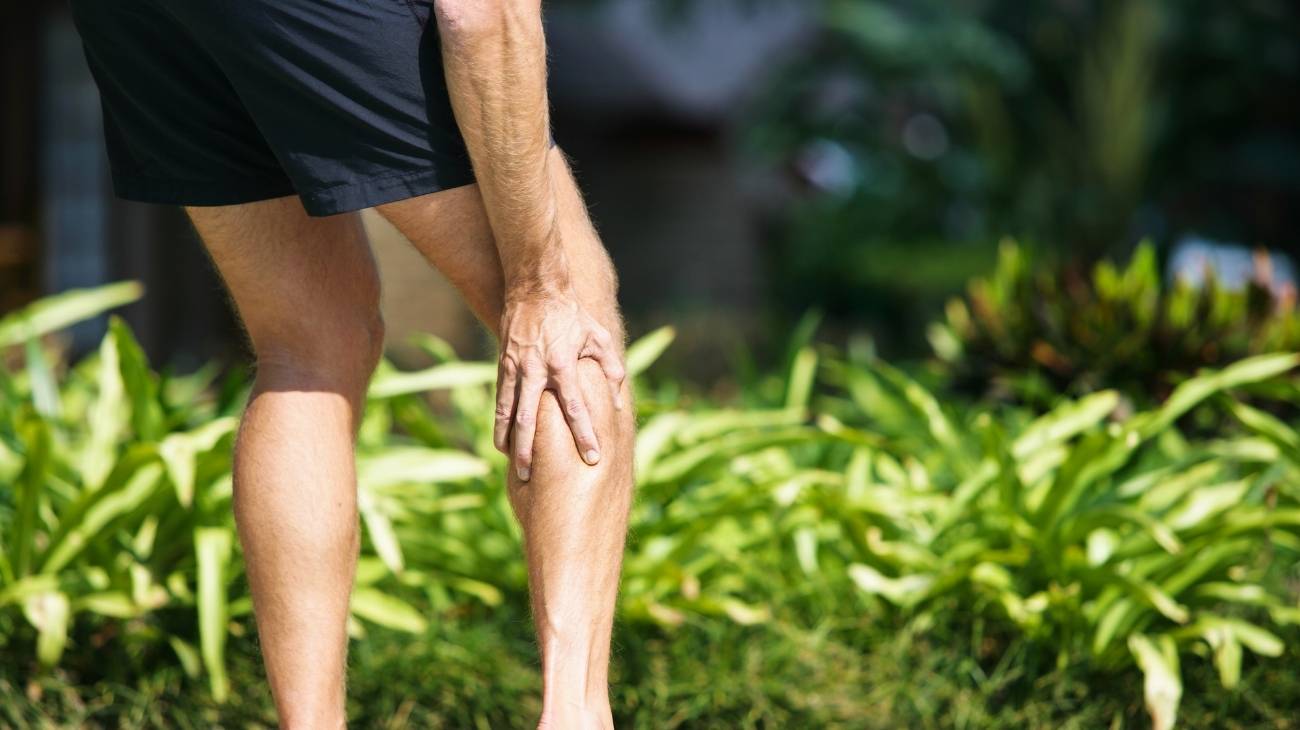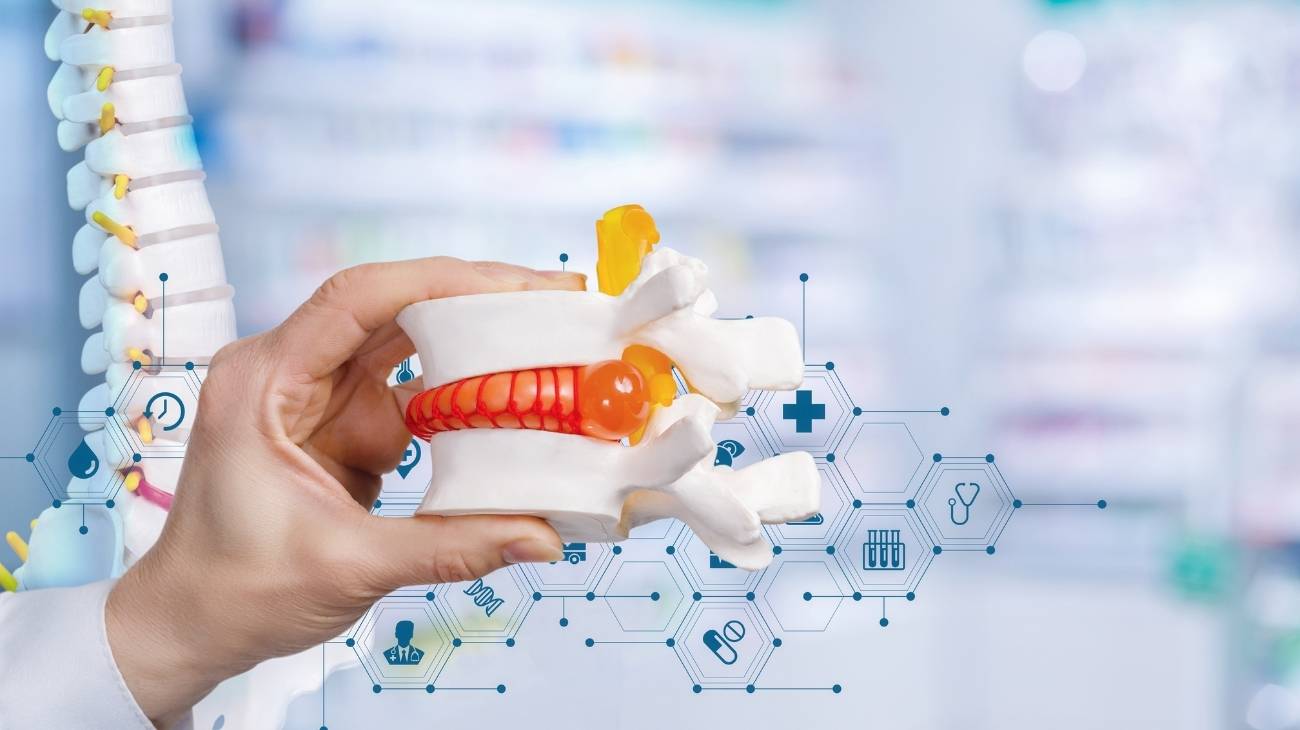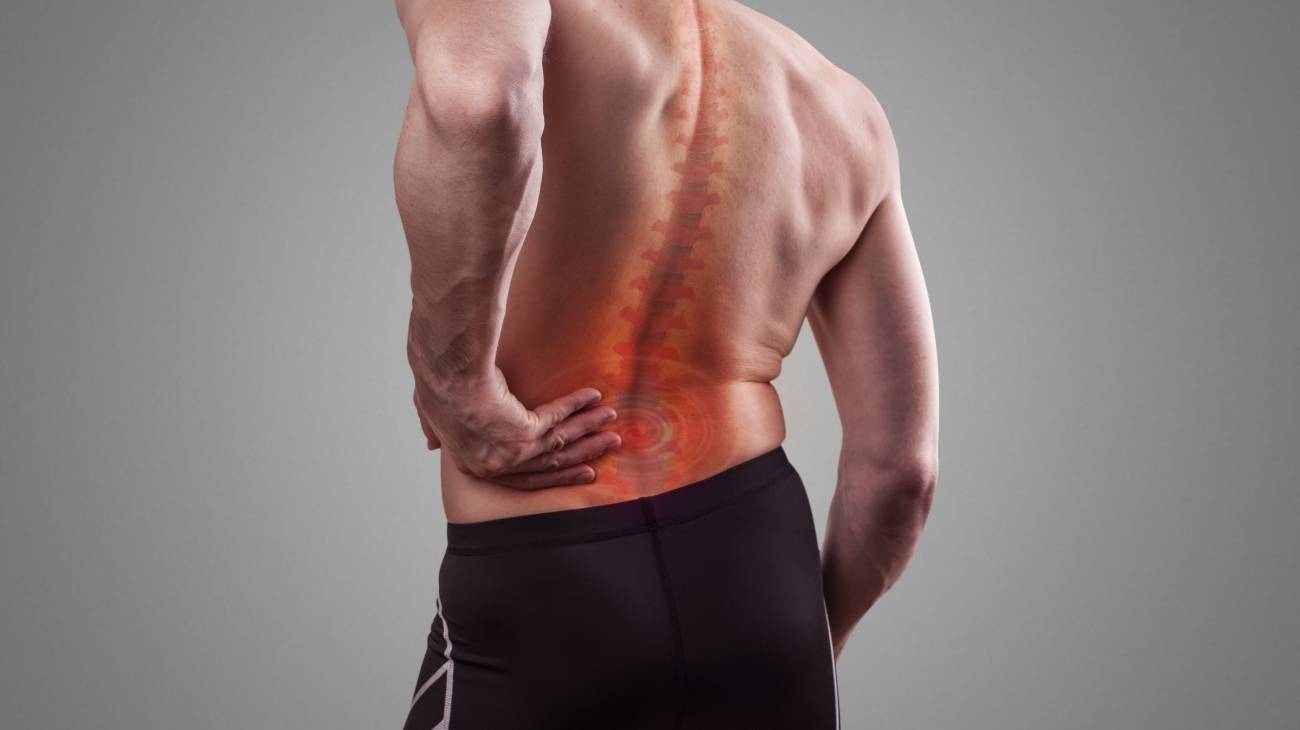- Definition: What is sciatica or inflammation of the sciatic nerve?
- Best products for back pain relief
- What are the causes and risk factors for sciatic nerve impingement?
- Main signs and symptoms that warn us of sciatica in the back
- What tests are available to diagnose the onset of sciatica?
- What treatments are available to relieve sciatica pain?
- Which methods of prevention for sciatica are the most effective?
- F.A.Q: Frequently asked questions
When there is inflammation or compression of the sciatic nerve, it triggers severe pain that travels from the lower back, through the buttocks and down the back of the leg. This is known as "sciatica" and is an underlying medical condition that impacts up to 40% of the adult population.
However, although it is a recognised condition, there are actually still many misconceptions about what sciatica is. So here we will tell you what sciatica is, what causes it, what symptoms it has, what treatment is available and how it can be prevented.
Definition: What is sciatica or inflammation of the sciatic nerve?
The sciatic nerve (or sciatica) is the largest nerve in the human body and is made up of several nerve endings coming from the spinal column. Therefore, it starts at the end of the spine, runs towards the buttocks and passes through the back of the thigh until it reaches the knee, where it divides into the tibial and common fibular nerves.
The condition associated with sciatica, on the other hand, is not a disease in itself, but a term that is generally used to describe the ailment that occurs when the nerve roots in the lower back (or lumbosacral spine) become compressed, inflamed or irritated. As a result, this condition refers to a marked discomfort that radiates along the path of the sciatic nerve and generally affects only one side of the body.
Although most sciatica-related pain can be severe, in almost all cases, specialists resolve the condition with non-surgical treatment for several weeks. However, if the patient manifests severe sciatica that causes bladder or bowel changes and is associated with severe leg weakness, these cases may be candidates for surgery.
Best products for back pain relief
Bestseller
-
Microwave Wheat Bag for Back Pain Relief (Extra Large) (Hearts)
£24,95 -
Microwave Wheat Bag for Back Pain Relief (Extra Large) (Oxford)
£24,95 -
Microwave Wheat Bag for Back Pain Relief (Extra Large) (Sport)
£24,95 -
Microwave Wheat Bag for Neck & Shoulder Pain Relief (Hearts)
£24,95 -
Microwave Wheat Bag for Neck & Shoulder Pain Relief (Oxford)
£24,95 -
Microwave Wheat Bag for Neck & Shoulder Pain Relief (Sport)
£24,95 -
Microwaveable Wheat Bag for Pain Relief (Hearts)
£20,95 -
Microwaveable Wheat Bag for Pain Relief (Oxford)
£20,95 -
Microwaveable Wheat Bag for Pain Relief (Sport)
£20,95 -
Wheat Bag for Microwave Classic Bottle Shaped (Hearts)
£20,95 -
Wheat Bag for Microwave Classic Bottle Shaped (Oxford)
£20,95 -
Wheat Bag for Microwave Classic Bottle Shaped (Sport)
£20,95
-
Back Support Belt (Black)
£39,95 -
Back Support Belt (Green)
£39,95 -
Back Support Belt (Pink)
£39,95 -
Ice Massage Roller Ball (Black)
£34,95 -
Ice Massage Roller Ball (Green)
£34,95 -
Ice Massage Roller Ball (Pink)
£34,95 -
Sacroiliac Support Belt (Black)
£24,95 -
Sacroiliac Support Belt (Green)
£24,95 -
Sacroiliac Support Belt (Pink)
£24,95 -
Soft Density Foam Roller for Recovery (Black)
£34,95 -
Soft Density Foam Roller for Recovery (Green)
£34,95 -
Soft Density Foam Roller for Recovery (Pink)
£34,95
What are the causes and risk factors for sciatic nerve impingement?
One of the most frequent doubts about sciatica refers to the reasons that cause this condition and/or the risk factors that increase the probability of suffering a pinched sciatic nerve. For this reason, here we highlight the main causes that lead to the appearance of this ailment:
- Herniated discs: Undoubtedly, the most common reason for sciatic nerve pain is lumbar disc herniation. This type of herniated disc is a bulging of the inner white part of the disc by its outer fibrous part, which is also known as a "ruptured disc" and causes irritation of the neighbouring nerve root where it exits the spinal column.
- Lumbar canal stenosis: This is a common condition that causes sciatica, due to narrowing of the spinal canal. It is usually a pathology linked to natural ageing and as a result is common in adults over 60 years of age.
- Piriformis syndrome: If you suffer from piriformis syndrome, you may suffer from pain in the sciatic nerve. Because the sciatic nerve is irritated as it passes under the piriformis muscle in the buttock, and if the piriformis muscle pinches a nerve root that is involved in sciatica, it will automatically cause sciatica.
- Diabetes: is another pathological condition that tends to produce pain and/or inflammation in the sciatic nerve of sufferers. In view of the fact that, this condition impairs the way in which the body uses the sugar in the blood and thus increases the risk of injury to the nervous system.
- Sedentary lifestyle: This leads to obesity or being overweight, causes significant strain on the spine, and the enormous body weight contributes to the spinal changes that trigger sciatica in people.
- Age: Changes in the spine associated with the age of patients is another risk factor that triggers sciatic nerve disease.
- Muscle strain: Muscle strain also tends to cause sciatica, because inflammation related to muscle laxity is capable of putting pressure on a nerve root that causes sciatica.
- Pregnancy: The changes that pregnant women's bodies undergo during pregnancy, including weight gain and hormonal changes, also tend to cause sciatica.
- Physical activities: Some professions that require prolonged sitting, carrying heavy loads, twisting the back and driving a vehicle for long periods of time are other causes of sciatic nerve disease.
- Trauma: Due to certain blows to the lumbar area, it is possible that some of the vertebrae may shift, and this movement produces pinching of the sciatic nerve.
- Vertebral fracture or "spondylolysis": The sciatic nerve can also be compressed and cause severe pain.
Main signs and symptoms that warn us of sciatica in the back
Once the sciatic nerve becomes inflamed, certain signs and symptoms appear which are typical of this condition triggered by some of the factors mentioned in the previous section. But, as it is an ailment that goes from the lower back to the legs, it also tends to be associated with other pathologies; therefore, it is relevant to know the following.
What are the main symptoms that warn that the patient is suffering from sciatica in the back, in order to be able to act appropriately in the face of the discomfort:
- Pain extends from the lower back (in the lumbar region) to the buttocks and the back of the leg. The pain worsens if the patient remains seated.
- Tingling sensation in the leg or foot in the affected region.
- Muscle weakness in the lower limb on the side that is impacted.
- Perception of electric shocks, burning and/or stinging in the buttock or leg.
- Alterations in the sensitivity of the skin innervating the sciatica.
- Reduction of muscle reflexes which sometimes limit movements of the hip and knee.
What tests are available to diagnose the onset of sciatica?
In order to detect sciatica, there are a number of simple tests that help the medical specialist to obtain a concise diagnosis of sciatica:
- Laségue test: To perform this manoeuvre, the patient must lie on their back and raise the outstretched leg on the affected side. If the pain increases before rising more than 60°, it is possible to conclude that the pain is due to the sciatic nerve. To verify that the discomfort only affects one of the sciatic nerves, this manoeuvre must be performed on both legs.
- Bragard test: This consists of the same movement as the Laségue manoeuvre and is performed after it. However, when the point of pain is reached, the patient must raise the limb further and the doctor must push on the sole of the foot by flexing the ankle. In this case, if the pain persists, the likelihood of sciatic pathology increases.
- Examination of muscle strength: The expert has to compare both sides of the body to detect whether there is a loss of strength in the muscles. The patient is usually asked to walk on tiptoe or heel. If he or she is unable to do so, it is likely that the sciatic nerve is affected, as it prevents the patient from walking in this way.
- Examination of sensation: The doctor who is diagnosing the condition must also check whether the sensation of the skin that supplies the sciatic nerve has been affected, especially in comparison with the side that has not been affected.
- Examination of the tendon reflexes: When the tendons are struck sharply, a reflex contraction of the muscle to which they belong is triggered. This is possible because the nervures form this reflex when they are healthy. However, when sciatica occurs, these reflexes disappear because they do not have the capacity to contract. In these cases, the Achilles tendon reflex in the ankle is often reduced.
What treatments are available to relieve sciatica pain?
Fortunately, to alleviate sciatic pain, patients can resort to different therapeutic techniques, dietary supplements, drugs and surgery (in the most severe cases) to help their bodies return to a state of normality by reducing inflammation of the sciatic nerve.
Therefore, here are the main treatments used to soothe the discomfort caused by sciatica, by default, in people:
Alternative and complementary therapies
One of the most effective methods to minimise the pain produced in the sciatic nerve is to undergo certain alternative therapies that tend to channel a healing response in the lumbar area and/or along the sciatic nerve in order to attenuate or eliminate the symptoms of the condition.
Below, we mention what they are and what they are about:
- Heat and cold therapy: This complementary treatment, which combines heat and cold to moderate pain and reduce inflammation in various areas of the body, is widely used to improve sciatica. For that, you have to apply a low temperature (cold) to the affected lower back or buttock to reduce the swelling that accompanies nerve compression, with cold water compresses or ice. As well as, superimposing heat with a hot gel pack or electric blanket to relieve pain. This should be done alternately for 20 to 30 minutes and repeated every two hours.
- Compression therapy: The use of orthopaedic or sports back supports can help to immobilise the area by providing pressure and warmth, both of which can help to alleviate the cramping sensation caused by this ailment. Compression therapy facilitates the circulation of the blood supply and this helps to recover from certain injuries. For a good use of this therapy, it is best to go to a specialist who will recommend a good compression garment that meets all the quality standards.
- Massage therapy: On a therapeutic level, massage of the lumbar region is completely beneficial for patients suffering from sciatic nerve pain. By rubbing the painful area, it is possible to increase the blood flow which helps to minimise the discomfort along the nerve. For this, it is appropriate to see a trained massage therapist or physiotherapist who uses moisturising creams or oils to implement eastern and western techniques to soothe the pain, optimise mobility and relax the muscles of the back, buttocks and legs to reduce compression on the nerve.
- Acupressure therapy: Another method or therapy to treat the sciatic nerve in a non-surgical way is acupressure, which is a therapy designed by traditional Chinese medicine that uses pressure exerted on an area of the body to soothe pain by stimulating strategic points that correspond to organs, emotions and feelings. To do this, acupressure experts apply controlled force with fingers or elbows, a ball or a compact object for about 2 minutes on or near the lower back area at a point known as a "trigger" to mitigate symptoms.
- Thermotherapy: Local thermotherapy is another ideal treatment to provide a cure for sciatica patients. In view of the fact that it guarantees an analgesic, anti-inflammatory and sedative effect on whatever area of the body is impacted. Thus, for the sciatic nerve, experts recommend applying superficial heat to the lumbar area (or a temperature higher than body temperature) which is the main basis of thermotherapy.
- Natural remedies using plants: Due to their pain-relieving and anti-inflammatory properties, many plants are recommended to alleviate this ailment that extends from the back and passes through the buttocks to the legs. Taking into account that, in this case, patients can resort to the following natural remedies: consume ginger, apply warm compresses of eucalyptus leaves, drink green tea, take a bath with nettle infusion and drink two or three cups of willow daily.
- Healthy lifestyle habits: Another effective way of attacking sciatic nerve pain is based on acquiring certain healthy lifestyle habits which, as well as alleviating the pain, are also capable of preventing it on future occasions. We recommend the following: Practising exercises to strengthen the muscles of the lumbar area, doing yoga or meditation to relax sciatic and lumbar pain, avoiding long walks and/or overexertion, having a healthy and balanced diet, as well as, carrying out correct stretching for the lumbar region.
Dietary supplements
A useful complementary formula to minimise the symptoms that cause sciatic nerve pain and even prevent it, is to combine food with dietary supplements that help to increase the optimisation of the functions of each part of the organism. Because, if the body obtains the required amounts of vitamins, minerals, enzymes, amino acids and fatty acids, it will prevent certain disorders such as sciatica from being triggered.
For this reason, below, we will tell you which are the best food supplements approved to act against sciatica and thus, have a much more pleasant life:
- Thiamine or vitamin B1: This vitamin plays a fundamental role in the nervous system, as it helps to improve its functioning and also manages to intensify the action of some substances produced by the body to promote the transmission of nerve impulses. Therefore, this vitamin of the B complex has the power to prevent sciatic pain in people and, basically, it can be acquired from the following food sources: milk, eggs, fish, pork, liver, whole grains, legumes and brewer's yeast.
- Vitamin B12 or Cobalamin: Deficiency of vitamin B12 in the human body tends to generate neurological signs because it supports the incorrect functioning of the nervous system and produces conditions such as sciatica. Therefore, it is also essential to consume this vitamin from certain foods such as liver, meat, fish, milk, eggs and derivatives of these foods. Cobalamin is only synthesised in micro-organisms.
- Vitamin B6 or Pyridoxine: As in the previous case, if the organism shows a deficiency of this vitamin belonging to the B complex, it causes deterioration of the operation of the nervous system and can affect the sciatic nerve as a consequence. Thus, to avoid this condition and even to attenuate the pain it generates (thanks to the high doses it provides as an analgesic), it is appropriate to consume vitamin B6, which is found in cereals, liver, legumes, bananas and nuts, but is also abundant in all foods.
Now, it is important to note that a harmonious combination of these three B vitamins is essential to reap the benefits of the sum of the effects that each of them has on the body. Thus, it is ideal to use them as an additional treatment for sciatica, in conjunction with a varied and healthy diet that helps to relieve the symptoms of the ailment in this important nerve.
Physiotherapy treatments
While it is true, physiotherapy is defined as a discipline of health science that is used as a healing method for some physical injuries or illnesses, thanks to the optimal rehabilitation process it provides. As a result, some physiotherapy exercises are indicated as a treatment plan for sciatica, as it involves strengthening, stretching and aerobic conditioning to trigger a resuscitative response.
Therefore, another way to improve sciatica symptoms is to perform physiotherapy exercises to help patients recover faster from pain and even reduce the likelihood of future sciatic nerve attacks. Thus, in this case, the recommended exercises to treat this condition are based on one of three key areas that will depend on the underlying medical condition causing the sciatic pain, and they are:
- Stretching exercises: Stretching exercises are generally recommended by specialists to minimise sciatic nerve pain. In this case, such practices are designed to exercise muscles that tend to generate damage when they are inflexible or stiff. Taking into account that, in most processes, stretching of the hamstring is used to act positively on sciatica.
- Strengthening exercises: Exercises that serve to strengthen the spine, ligaments, tendons and muscles that support it are vital to treat this ailment. For this purpose, in addition to focusing on comforting the lower back, they also focus on intervening in the abdominal muscles, buttocks and chain muscles to relieve pain, as they support the spine. They can keep the spine in alignment and simplify movements that rotate or stretch the spine to reduce the likelihood of injury.
- Low-impact aerobic exercise: Physical activities such as walking, swimming or water aerobics, i.e. low-impact cardiovascular exercises, are also included in the treatment of sciatica. In view of the fact that, in the recovery process, these activities promote the exchange of fluids and nutrients to create an excellent healing environment. In addition, aerobic conditioning works as a natural analgesic for the body and thereby decreases sciatic pain.
Medications
If, after two weeks, the patient is still experiencing pain in the lower back and/or along the sciatic nerve, it is best to see a specialist doctor, rather than self-medicating with unprescribed medication. This could lead to serious side effects such as dizziness, fainting, nausea, diarrhoea, drowsiness, dependence, addiction and even cardiac arrest.
Whereas, if you contact a health professional, he or she will have the power to prescribe muscle relaxants and strong painkillers that will provide a good treatment to end the condition. Apart from this, the doctor will be able to study your case in detail, in order to go further and discover the cause of the pain, as well as to identify the region where the nerve is compressed.
Surgery
In very severe cases, individuals suffering from sciatica must undergo surgery in order to be cured of the condition in its entirety. Considering that such severity results in an acute condition that does not improve within 6 to 12 weeks, lower back surgery should be considered.
However, depending on the duration and cause of the sciatic pain, two alternative surgical operations are considered:
- A minor open surgery (or microdiscectomy): As a rule, specialised doctors are forced to resort to this type of operation when sciatica is triggered by a herniated disc. For this reason, it is a process characterised by the removal of the part of the herniated disc that is pinching the sciatic nerve. In order to consider it, patients must wait between 4 and 6 weeks, normally, to verify that the pain is not minimised.
- An open decompression (or lumbar laminectomy): If the condition is caused by lumbar canal stenosis, an open decompression is advised, which involves removing the small portion of disc material or bone that is impinging on the nerve root. In this case, the patient's general health is a factor that may affect the decision to operate.
Which methods of prevention for sciatica are the most effective?
Just as it is possible to alleviate the pain of a sciatica injury, people also have the option of considering certain methods to prevent sciatica.
Therefore, it is of great importance to know what these techniques are and here, we invite you to find out which measures are the best ones to take:
- Engage in regular, gradual physical activity, such as walking, hydro-gymnastics, pilates, swimming or tennis, for example. To strengthen and stretch your muscles, as well as to prevent a sedentary lifestyle.
- Avoid obesity and/or being overweight, which, apart from triggering sciatic pain, also has a negative effect on the functioning of the body.
- Take up yoga. Yoga helps to maintain a good muscle tone, helps to release accumulated tensions and even calms sciatic or lower back pain significantly. It even has a positive influence on your mood.
- Stop carrying heavy weights: This can easily impact the sciatic nerve.
- Adopt good posture when sitting: It is important that the lumbar region can always be supported by the backrest or a cushion for comfort.
- Maintain good back post ure: This is another effective way to prevent sciatica, both when standing and sitting.
- Stretching exercises: You should also stretch regularly and correctly. This will help the muscles in your spine and legs to stretch and maintain their good condition.
- Sleep on a rigid and flexible mattress: If the mattress you sleep on has these characteristics, your spine will be able to stay in an upright position to avoid injuries.
- You have to bend the right way: It is vital that you don't bend over with your back bent, as this is inaccurate and tends to cause discomfort. So learn to bend at the knees with your back straight.
F.A.Q: Frequently asked questions
Finally, we will answer the most common doubts that people have about this pathology that impacts many people in the world:
References
- Valat, J. P., Genevay, S., Marty, M., Rozenberg, S., & Koes, B. (2010). Sciatica. Best practice & research Clinical rheumatology, 24(2), 241-252. https://www.sciencedirect.com/science/article/abs/pii/S1521694209001417
- Koes, B. W., Van Tulder, M. W., & Peul, W. C. (2007). Diagnosis and treatment of sciatica. Bmj, 334(7607), 1313-1317. https://www.bmj.com/content/334/7607/1313?flh=
- Frymoyer, J. W. (1988). Back pain and sciatica. New England Journal of Medicine, 318(5), 291-300. https://www.nejm.org/doi/pdf/10.1056/NEJM198802043180506
- HELIÖVAARA, M., MÄKELÄ, M., KNEKT, P., IMPIVAARA, O., & AROMAA, A. (1991). Determinants of sciatica and low-back pain. Spine, 16(6), 608-614. https://journals.lww.com/spinejournal/Abstract/1991/06000/Determinants_of_Sciatica_and_Low_Back_Pain.2.aspx
- Konstantinou, K., & Dunn, K. M. (2008). Sciatica: review of epidemiological studies and prevalence estimates. Spine, 33(22), 2464-2472. https://journals.lww.com/spinejournal/Abstract/2008/10150/Sciatica__Review_of_Epidemiological_Studies_and.18.aspx
- Vroomen, P. C., de Krom, M. C., Slofstra, P. D., & Knottnerus, J. A. (2000). Conservative treatment of sciatica: a systematic review. Clinical Spine Surgery, 13(6), 463-469. https://journals.lww.com/jspinaldisorders/Abstract/2000/12000/Conservative_Treatment_of_Sciatica__A_Systematic.1.aspx
- Peul, W. C., Van Houwelingen, H. C., van den Hout, W. B., Brand, R., Eekhof, J. A., Tans, J. T., ... & Koes, B. W. (2007). Surgery versus prolonged conservative treatment for sciatica. New England Journal of Medicine, 356(22), 2245-2256. https://www.nejm.org/doi/full/10.1056/NEJMoa064039
- Hofstee, D. J., Gijtenbeek, J. M., Hoogland, P. H., van Houwelingen, H. C., Kloet, A., Lötters, F., & Tans, J. T. J. (2002). Westeinde sciatica trial: randomized controlled study of bed rest and physiotherapy for acute sciatica. Journal of Neurosurgery: Spine, 96(1), 45-49. https://thejns.org/spine/view/journals/j-neurosurg-spine/96/1/article-p45.xml
- Wheeler, A. H. (1995). Diagnosis and management of low back pain and sciatica. American family physician, 52(5), 1333-41. https://europepmc.org/article/med/7572557
- Fritz, J. M., Lane, E., McFadden, M., Brennan, G., Magel, J. S., Thackeray, A., ... & Greene, T. (2021). Physical therapy referral from primary care for acute back pain with sciatica: a randomized controlled trial. Annals of internal medicine, 174(1), 8-17. https://www.acpjournals.org/doi/abs/10.7326/m20-4187








































































